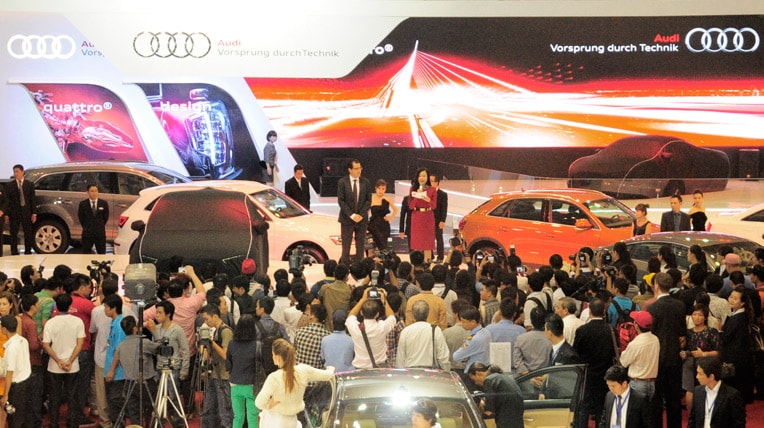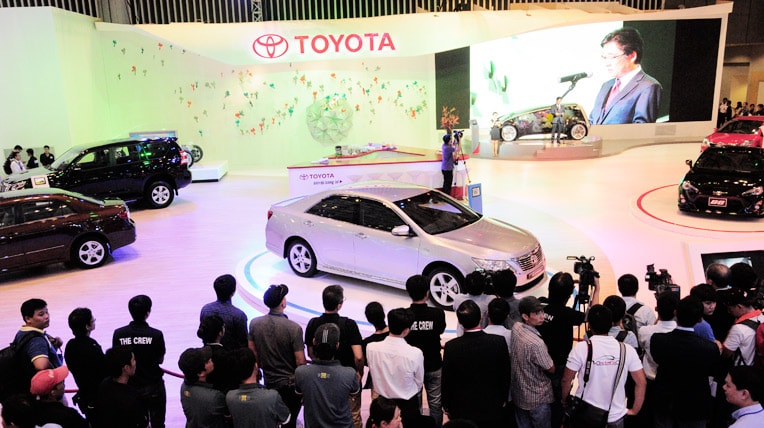Domestic cars: Give way or lose?
Even from a policy perspective, it is still possible to clearly see the desire to hold on to hope for the domestic automobile industry. However, the delay in making breakthrough decisions is invisibly creating a huge gap for imported cars to surpass strongly.
In less than 4 years, a massive influx of cars from ASEAN countries will be inevitable. With a zero tax rate, the price advantage will bring superior competitiveness, even absolute, for imported cars from this bloc.
In recent times, this long-foreseen pressure has become more severe and more evident. A few statistics are enough to show this.
Statistics from the General Department of Customs (Ministry of Finance) show that in the first three months of this year, the number of completely built-up cars imported from ASEAN, more precisely Indonesia and Thailand, has increased sharply.
 |
| Imported cars are outperforming strongly. |
Specifically, 2,117 complete cars were imported from Indonesia and Thailand in the first quarter of 2014, reaching a turnover value of over 32.3 million USD. Knowing that, the figure for the same period last year was only 1,686 cars and the turnover value was nearly 28 million USD.
Notably, the acceleration of imported cars from Thailand is increasing at a dizzying speed. A small comparison is quite worrying: the total import turnover of cars from ASEAN in the first 3 months of last year was only equal to the turnover from neighboring Thailand alone in the first 3 months of this year (1,746 cars and 28.8 million USD).
Not to mention, in the last 3 consecutive months, the import turnover of cars from Thailand has also been increasing strongly in terms of both quantity and value. Specifically, the turnover of the first month of the year was only 338 cars and 4.7 million USD, but in February it doubled to 678 cars and 11.2 million USD, the turnover of March was 730 cars and approximately 12.9 million USD.
Most recently, the General Statistics Office (Ministry of Planning and Investment) also released startling figures. It is estimated that the import turnover of automobiles in April 2014 is estimated to reach 5,000 units and 130 million USD, thereby raising the total turnover of the first 4 months of the year to 15,000 units and 329 million USD, up 53.4% in volume and 76.6% in value compared to the same period last year.
 |
| The less than four-year timeframe to 2018 can even be considered meaningless for efforts to have a real auto manufacturing industry. |
Of course, the continuous increase in car import turnover is partly due to the general recovery of the whole market. However, the worrying factor is the comparison of growth rate between imported cars and domestically assembled cars.
According to the sales report of the Vietnam Automobile Manufacturers Association (VAMA), the total sales volume of domestically assembled vehicles (CKD) in the first quarter of 2014 reached 21,488 units, an increase of 24% compared to the same period last year. Meanwhile, the number of imported vehicles (CBU) reached 8,539 units, an increase of 98%. Clearly, this overwhelming difference is pointing out concerns for domestically produced and assembled cars.
Despite the great pressure, as mentioned above, the policies that are expected to create a breakthrough for the domestic automobile industry have not yet been implemented. For example, the strategy and planning for the automobile industry in the new period until 2020 and vision to 2030, which was chaired by the Ministry of Industry and Trade, has not yet been completed.
According to experts, the period of less than 4 years to 2018 can even be considered meaningless for the efforts to have a real automobile manufacturing industry, not to mention whether it is capable of fair competition or not, from a certain perspective it is like we are losing to completely imported cars. And, the delay in issuing policies to promote (or break through) the automobile industry, is no different from a proactive concession.
According to chinhphu.vn






